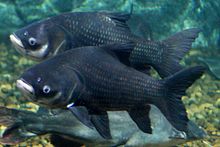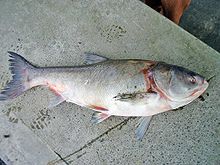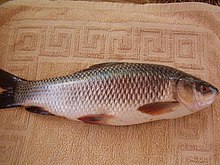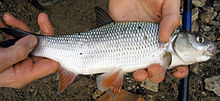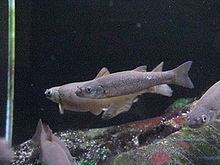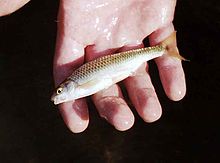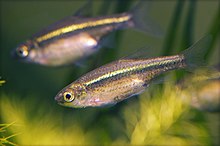
Cypriniformes is an order of ray-finned fish, including the carps, minnows, loaches, and relatives. Cypriniformes is an Order within the Superorder Ostariophysi consisting of "Carp-like" Ostariophysins. This order contains 11-12 families, although some authorities have designated as many as 23, over 400 genera, and more than 4,250 species, with new species being described every few months or so, and new genera being recognized frequently. They are most diverse in southeastern Asia, and are entirely absent from Australia and South America. At 112 years old, the longest-lived cypriniform fish documented is the bigmouth buffalo.

Cobitidae, also known as the True loaches, is a family of Old World freshwater fish. They occur throughout Eurasia and in Morocco, and inhabit riverine ecosystems. Today, most "loaches" are placed in other families. The family includes about 260 described species. New species are being described regularly.

Phoxinus is a genus of freshwater fish in the family Leuciscidae of order Cypriniformes, and the only members of the subfamily Phoxininae, or Eurasian minnows. The type species is Phoxinus phoxinus. The other species in this genus are also commonly known as minnows. The name "minnow" was what early English fisherman used to describe "small and insignificant". The genus Phoxinus is found throughout Eurasia, and includes 21 known species. Previously, members of the North American genus Chrosomus were also believed to form part of this genus.

Barbus is a genus of ray-finned fish in the family Cyprinidae. The type species of Barbus is the common barbel, first described as Cyprinus barbus and now named Barbus barbus. Barbus is the namesake genus of the subfamily Barbinae, but given their relationships, that taxon is better included in the Cyprininae at least for the largest part.

Puntius is a genus of small freshwater fish in the family Cyprinidae native to South Asia and Mainland Southeast Asia, as well as Taiwan.

Rhinichthys, known as the riffle daces, is a genus of freshwater fish in the carp family (Cyprinidae) of the order Cypriniformes. The type species is Rhinichthys atratulus, the blacknose dace. Rhinichthys species range throughout North America.

Microrasbora is a genus of small fishes. The generic name means "small Rasbora", however these are more closely related to the danios than rasboras. They inhabit freshwater in Myanmar and Yunnan, China.

Garra is a genus of fish in the family Cyprinidae. These fish are one example of the "log suckers", sucker-mouthed barbs and other cyprinids commonly kept in aquaria to keep down algae. The doctor fish of Anatolia and the Middle East belongs in this genus. The majority of the more than 140 species of garras are native to Asia, but about one-fifth of the species are from Africa.

Danio erythromicron, often known as emerald dwarf danio and emerald dwarf rasbora, is a species of cyprinid fish which is endemic to Inle Lake in Myanmar.

The bitterling-like cyprinids form the cyprinid subfamily Acheilognathinae. This subfamily contains four genera, although the Khanka spiny bitterling is often placed in Acheilognathus, and at least 71 described species to date. Over half of the species are in the genus Acheilognathus.
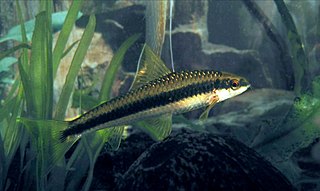
Labeoninae is a doubtfully distinct subfamily of ray-finned fishes in the family Cyprinidae of order Cypriniformes. They inhabit fresh water and the largest species richness is in the region around southern China, but there are also species elsewhere in Asia, and some members of Garra and Labeo are from Africa. They are a generally very apomorphic group, perhaps the most "advanced" of the Cyprinidae. A common name for these fishes is labeonins or labeoins.

Hypselobarbus is a genus of fish in the family Cyprinidae endemic to India.

Leuciscinae is a subfamily of the freshwater fish family Cyprinidae, which contains the true minnows.

Loaches are fish of the superfamily Cobitoidea. They are freshwater, benthic (bottom-dwelling) fish found in rivers and creeks throughout Eurasia and northern Africa. Loaches are among the most diverse groups of fish; the 1249 known species of Cobitoidea comprise about 107 genera divided among 9 families.
Metzia is a genus of cyprinid fish that is found in eastern Asia. The genus is named in honor of the American ichthyologist Charles William Metz of Stanford University.

The danionins are a group of small, minnow-type fish belonging to the family Cyprinidae. Species of this group are in the genera clades danio and devario, based on the latest phylo-genetic research by Fang et al in 2009. They are primarily native to the fresh waters of South and Southeast Asia, with fewer species in Africa. Many species are brightly coloured and are available as aquarium fish worldwide. Fishes of the danio clade tend to have horizontal stripes, rows of spots, or vertical bars, and often have long barbels. Species within the devario dlade tend to have vertical or horizontal bars, and short, rudimentary barbels, if present at all. All danionins are egg scatterers, and breed in the rainy season in the wild. They are carnivores, living on insects and small crustaceans.

Gobioninae is a monophyletic subfamily of Eurasian cyprinid fishes. A species-rich subfamily, it is divided into five tribes: Gobionini, Pseudogobionini, Hemibarbini, Coreiini, and Sarcocheilichthyini.

Alburninae is a small subfamily of the carp and minnow family of ray-finned fish, the Cyprinidae. The genera in this subfamily were previously considered to be part of the Leuciscinae, but if the three Alburninae genera are included in that subfamily, it is paraphyletic. The Alburninae are still a contentious group and some authorities consider it to consist of two distinct clades, making it biphyletic.

Squaliobarbinae is a small subfamily of the carp and minnow family, Cyprinidae, which consists of three monotypic genera which have their natural distributions in eastern Asia. Two species, the grass carp and the black carp, have been introduced to other parts of the world for weed control and aquaculture. They are large cyprinids characterised by an enlarged subtemporal fossa, the palate articulating with the supraethmoid, an enlarged intercalar bone in the cranial vault, and a divided levator posterior muscle.

Xenocyprinae, is a contentious subfamily of the family Cyprinidae, the carp and minnow family, originally from eastern Asia.

